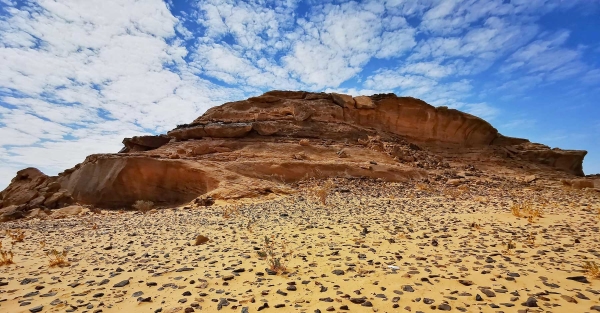
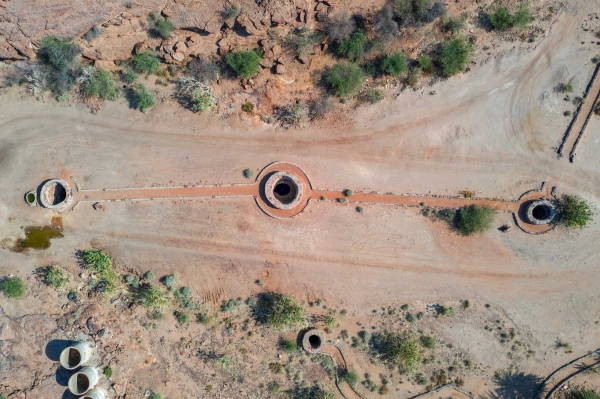
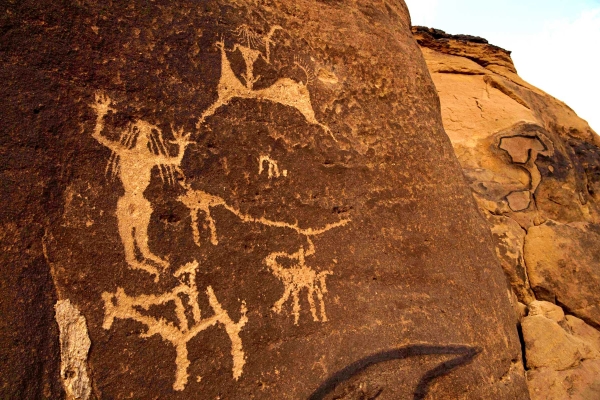
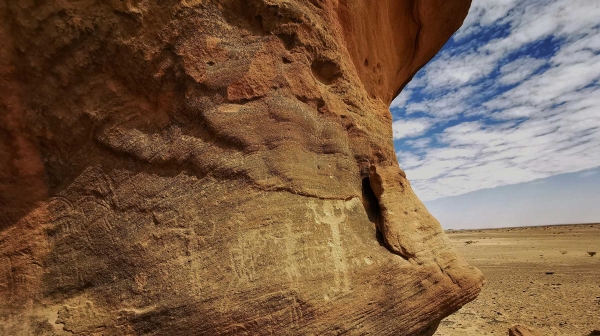
Hima Cultural Area is an archaeological site in Najran Province in the south of the Kingdom of Saudi Arabia, located in Thar Governorate, approximately 130 km north of the city of Najran. The area is abundant in various archaeological remains and landmarks of human civilizations that recount a history dating back to the seventh millennium BC.
Hima Cultural Area is considered one of the largest rock art complexes globally. The rock art area spans over 557 km², containing around 550 rock art panels featuring hundreds of thousands of inscriptions and rock drawings. Additionally, the Hima site encompasses Hima wells, including Umm Nakhlah, al-Qarayen, al-Janah, Soqya, al-Hamatah, and al-Habisah.
Hima Cultural Area monuments
Hima Area includes several archaeological sites, such as Jabal 'Sidah', Jabal 'Hima', 'Aan Jamal' Site, 'Shis'a', and 'al-Kawkab'. The site also includes the archaeological wells of Hima, including: Umm Nakhlah, al-Qarayen, al-Janah, Soqya, al-Hamatah, and al-Habisah. Most of those wells were excavated in the rocks, and they are considered to be one of the landmarks of civilization and ancient history in the Hima Area. It is surrounded by caves and mountains on all sides except the eastern side, and is full of rock drawings and inscriptions that include human and animal depictions.
The historical importance of the Hima Area
The area surrounding the Hima wells has been a site of human settlement for millennia and is renowned as one of the pivotal stations along the caravan routes spanning from the southern to the northern regions of the Arabian Peninsula, and vice versa. It stands as one of the most significant rock art sites in the Kingdom, boasting over thirteen locations. These sites showcase depictions of hunting and herding scenes, with human figures portrayed larger than life-size, accompanied by inscriptions in Thamudic, Southern Musnad, and Kufic scripts.
The continuous cultural succession in the area has contributed to the production of numerous antiquities and inscriptions across its various sites. It has been possible to identify around one hundred sites that have witnessed cultural movements throughout various periods. Recent archaeological discoveries in the area, made by specialized Saudi and international teams, have revealed civilizations dating back to the Stone Age. One significant achievement was the work of the Saudi-Japanese mission in cooperation with 'JICA' in 2002, which documented approximately ninety inscriptions distributed among sites such as Hima, al-Arissa, al-Khashibah, al-Masmaah, al-Naslaa al-Ulia, al-Kawkab, and other locations in Najran Province
The inscriptions and writings showcased the vitality of the Hima site and its significance as a hub of cultural and human communication across various time periods. One of the most notable inscriptions found at the site is that of King Yusuf Asar Yathar, who documented his victory over the Abyssinians in 518. The site also comprises a collection of ancient wells that served as a station for trade caravans. The inscriptions often depict scenes of battle or hunting, predominantly featuring spears adorned with decorations in the middle, as well as drawings of shields, bows, and arrows. Additionally, other drawings depict knives and blades, all of which were utilized in hunting or warfare.
Registering Hima Area on the World Heritage List
The World Heritage Committee of the United Nations Educational, Scientific and Cultural Organization 'UNESCO' announced during its forty-fourth session meetings on July 24, 2021, the inscription of the 'Hima Cultural Area' in Najran on the organization’s World Heritage List, recognizing it as a cultural site of exceptional value for human heritage. This marks the sixth Saudi heritage site to be registered on the list, following al-Hijr, al-Turayf neighborhood in historic Diriyah, Historic Jeddah, the rock art sites in Hail, and al-Ahsa Oasis.
Preparing the registration file for the Hima Cultural Area entailed three years of dedicated effort to align with the criteria set by the World Heritage Committee and to effectively demonstrate the "Outstanding Universal Value" of the site. Additionally, ensuring that the site would receive the necessary protection and treatment as a World Heritage site required close collaboration and partnership between the Heritage Commission and local officials. Following the successful listing of the site on the World Heritage List, the Heritage Commission orchestrated a ceremonial event in Hima area. During this event, an introductory presentation highlighting the significant archaeological features of the Hima Cultural Area was delivered to the attendees. This encompassed the exploration of rock art and inscribed stones from various civilizations, particularly those predating the Islamic era. Furthermore, the event showcased traditional heritage dishes originating from Najran Province.
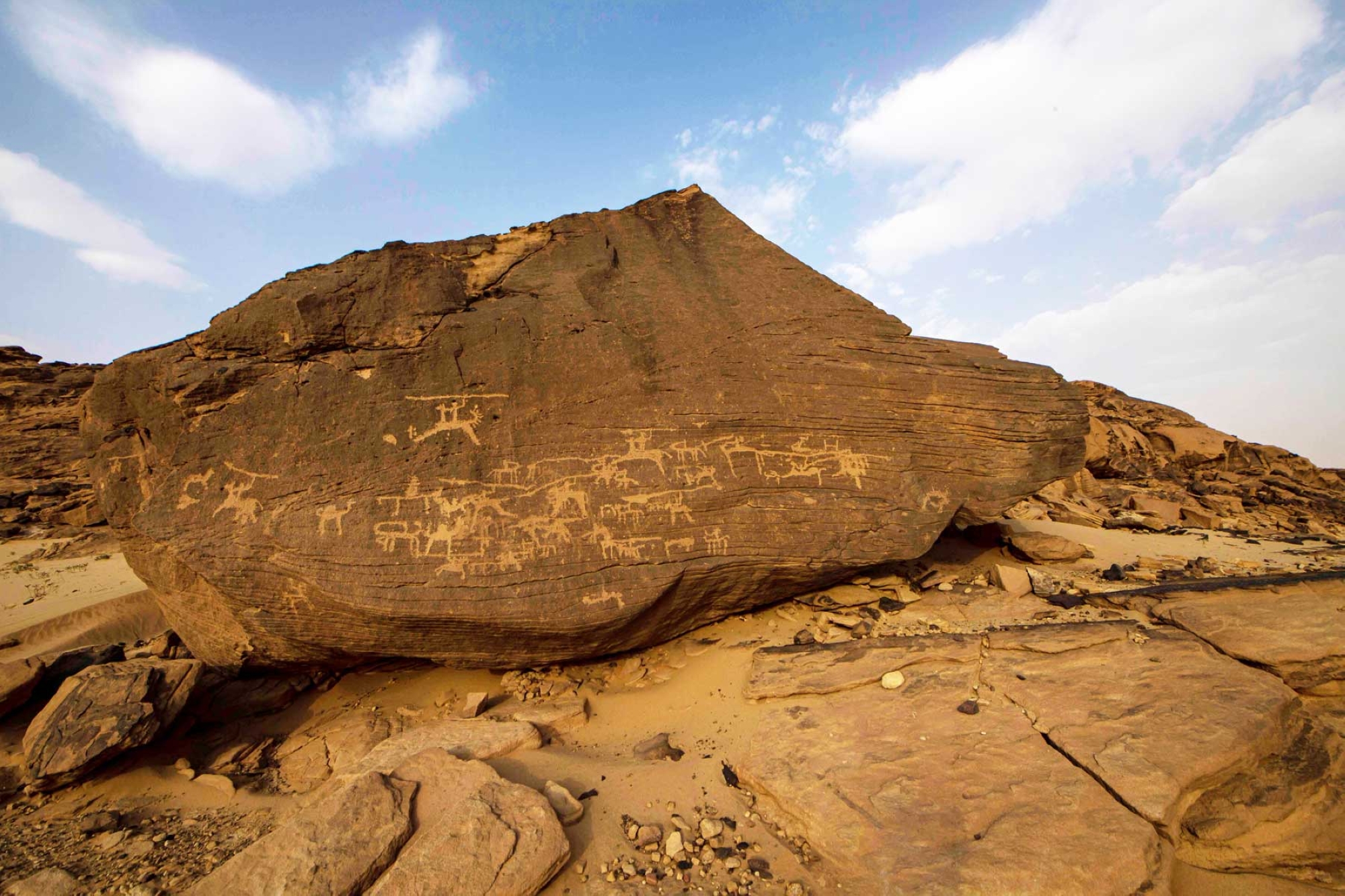
Archaeological sites in Hima Cultural Area
Jabal Saidah
Jabal Saidah is a prominent archaeological and tourist site, its significance rooted in its archaeological inscriptions that it retained across the ages. The mountain boasts a rich historical heritage and serves as a significant tourist destination, drawing visitors from both within the Kingdom and beyond. Tourists flock to admire the ancient drawings and inscriptions carved by humans into the mountain's rocky surfaces, as well as the stone tools employed in crafting these varied and elaborate scriptural depictions. These artifacts reflect the artistic prowess and ingenuity of ancient civilizations
Jabal al-Kawkab
It is among the sites rich in rock art in terms of drawings and writings. Due to the environmental diversity in the area surrounding Jabal al-Kawkab, the subjects engraved on the rocks are varied. The inscriptions on Jabal al-Kawkab serve as a historical record of many caravans that passed through the area, which explains the prevalence of camels and horses in the rock inscriptions. Their dense and repeated presence reflects the interest of the region's inhabitants since ancient times in acquiring and caring for these animals, boasting about them in their drawings and artistic subjects, indicating that they held an important place in their social and economic lives. The inscriptions also reveal the ancient artist's diverse skills, culture, and broad perception through the variety of artistic styles and social themes. They showed the presence of predatory animals during that period, such as lions, with drawings found in various places on the rock facades.
Farzah Al Hijab site
It is located between Hima Wells and Aan Jamal, 6.2 km northeast of Hima Wells. It's a cemetery dating back to the era immediately preceding the Iron Age. It contains rock drawings and inscriptions, as well as tombs situated on hilltops and rocky hills. These tombs are constructed using arranged stones and slabs made from black sandstone sourced from the same area. Some of these tombs have a comet-shaped form with long tails, measuring tens of m in length. While some sources traditionally attribute this type of tomb to the Bronze Age, excavations conducted at nearby sites in Yemen have revealed that such tombs continued to be used into the Iron Age.
Al-Khashibah site
It is a small gorge located on the eastern edge of the Jabal al-Kawkab site, representing a circle carved into the sandstone rocks, with a depression in the center where water collects when it rains. This site constitutes an important station for the caravans that depart from the Aan Jamal site to the Aan Halkan site. The diameter of this natural circle is thirty m. The rock facades at al-Khashibah site include hundreds of rock drawings and inscriptions. As for the rock drawings at the site, they constitute a small percentage compared to what was found at the Aan Jamal and Aan Halkan sites, as they constitute 12 percent of the general total of inscriptions and drawings, while they constitute 23 percent in Aan Halkan and 31 percent in Aan Jamal. These drawings were executed by carving or incising the surface of the sandstone rocks. They include three camels, two snakes, one ostrich, three cows, three unspecified animals, three human figures, one human with an arrow, five riders, and one of the drawings depicts isolated hands.
Regarding the rock inscriptions and engravings at al-Khashibah site, a total of 262 rock inscriptions were recorded, falling into two types: the first involves carving using a stone or sharp tool, while the second entails incising using a scraping tool or stone on sandstone rocks. Excavation works revealed that these inscriptions were generally not precise, except for some where dates can be determined based on the style of the script. Some of these inscriptions date back to the Himyarite era, while others are inscribed in ancient Kufic script. Additionally, various types of scripts and languages were found at the site, including 190 Southern Arabian inscriptions, written in the Southern Arabian alphabet. Most of these contain names of individual figures, such as the engravings of 'Nasram', 'Nashun', and 'Lahi Athat' among others. Some inscriptions consist of two names, like 'Nasr Nashun', and occasionally include the name of a person's father, such as the inscription 'Asdam Bin Qadran'. The inscriptions rarely contain the names of families or tribes to which the owners of the inscriptions belong.
The site of al-Khashibah also includes Thamudic inscriptions totaling fifty inscriptions, written in an ancient North Arabian script. These inscriptions mainly consist of simple or compound proper names and are relatively few compared to other scripts. They are concentrated at the bottom of the rocks. In addition, there are a few Nabataean inscriptions, totaling only two inscriptions, alongside Arabic Islamic inscriptions, one of which is recorded as the second oldest Islamic inscription, dating back to the year 644. Most of the Islamic inscriptions contain names such as 'Mohammed, Shahid, and Khalid', and some of them are religious phrases including prayers for mercy on the deceased.
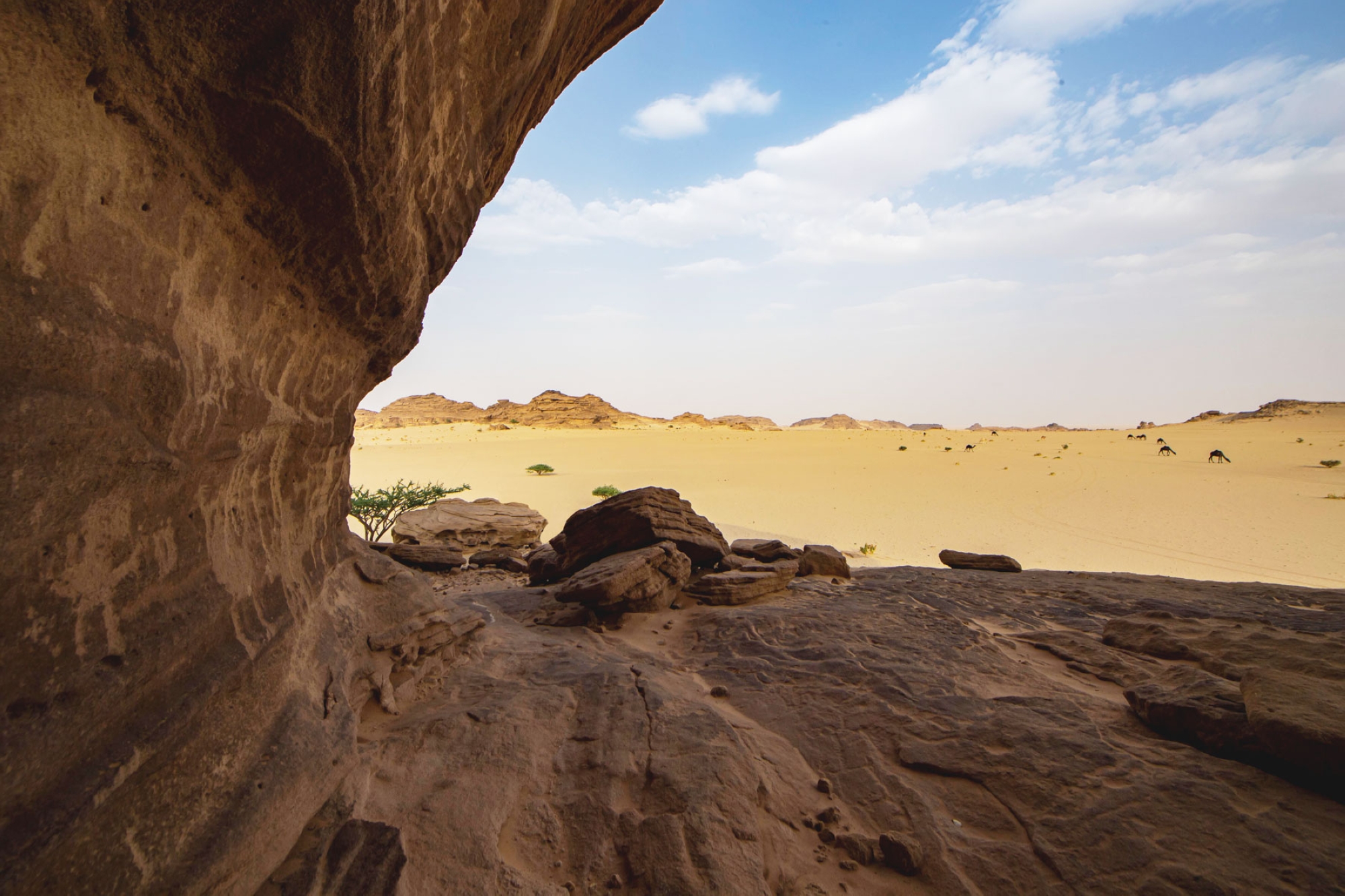
Wadi al-Misma
It is one of the valleys within the Hima Cultural Area, consisting of a mountain made of sturdy limestone located at an elevation of 1,275 m. In its lower sections, there are several panels filled with Thamudic inscriptions and rock drawings unevenly distributed. Some of these panels are densely packed with small-sized drawings, including young cattle, camel shapes, realistic camel drawings with two camel drivers, women, and horsemen, as well as several Thamudic writings.
Aan an-Na'amah
In the northeast of Jabal al-Qarah lies a rocky mountain range, covered by the sands of Nufud al-Misma, known as 'Jabal al-Karmah'. To its north and west stands a rocky formation named 'Aan al-Naamah'. On its far western flank, a panel displays numerous overlapping drawings of various types. The chronological sequence of these drawings can be discerned through the method and color of the inscriptions. Among the darker drawings are circular-shaped gazelles, large-sized people, large cattle, and Thamudic writings. The relatively darker drawings depict roughly drawn camels, while the lighter-colored ones portray large-sized people with disheveled hair and raised hands, alongside depictions of camels and horsemen wielding arrows or curved swords. Notably, one of these rock panels has been documented for its exceptional quality, featuring a realistic ostrich painted over Thamudic writings. At the top of this panel, a camel and a small ostrich are depicted in a clear color, akin to the larger ostrich.
Jabal as-Samaa
In the southern region of Wadi al-Samaa in Jabal al-Samaa, there are a number of rock panels painted and inscribed with Thamudic and South Arabian writings, depicting animals, humans, hunting scenes, and battles. Among these panels is the Jabal al-Samaa panel, which features large-sized humans with small heads, appearing to be women based on the shape of their bodies compared to other drawings found in various sites in Najran. These figures are depicted with raised arms, one of them holding a collar around their neck and a stick in their hand. The second site in Jabal al-Samaa contains three overlapping panels with inscriptions and drawings. The first panel shows a large-sized person with a small head and raised arm, large cattle, a large gazelle, a small camel, and Thamudic writings. The drawing method of the cattle is closer to Thamudic inscriptions, and the human figure depicted is lighter in color. The second panel features a small-sized camel, humans, and some Thamudic writings. The third panel contains a small-sized camel, one with a cameleer on its back, some Thamudic and South Arabian writings, and a scene of horsemen fighting. The third site in Jabal al-Samaa hosts several rare hunting and battle scenes. The first panel includes animals drawn in a simplistic style, a realistically depicted lion, and a small camel, while the second panel contains a realistically drawn camel, appearing as if it is embossed.
Wadi Shis'a
Wadi Shis'a features rock inscriptions and drawings on two rocks amidst the sands. The first rock, located in the south, showcases a large panel adorned with depictions of cattle and a donkey, and filled with recent South Arabian script, Kufic Arabic inscriptions, and human figures. The second rock displays several panels depicting palm trees, a woman, a Nabatean inscription, two ostriches, cattle, gazelles, South Arabian writings, and a word in Nabatean script. Additionally, scattered rocks in the vicinity bear multiple panels, drawings, and writings, including a South Arabian inscription referencing ancient trade caravans. A total of thirty-five inscriptions and scenes were documented on these rocks, among which are a Sabaean inscription attributed to a Hadrami named Reptoala from 1850, twenty-five South Arabian inscriptions mentioning a person of Hadrami origin, a Thamudic inscription, depictions of human figures, a panel portraying camels, a scene with arrows, and more cattle.
In Wadi Shis'a, there is also a series of rocks culminating in a peak, with their facades adorned with twenty panels of writings and rock drawings. Among these inscriptions, there is a lineage detailing an individual from the Qataban kingdom, one of the ancient kingdoms in the southern Arabian Peninsula, as well as another individual named "Hanki," affiliated with the tribes referenced in the inscriptions of al-Faw village. These inscriptions attest to the passage of South Arabian caravans through the Najran oasis. The complete collection of inscriptions on these rocks comprises 122 drawings and writings, spread across twenty-four panels: ninety-seven South Arabian inscriptions, eleven Thamudic inscriptions, two ancient Arabian inscriptions, ten depictions of horsemen, and two scenes portraying the hunting of ostriches or ibexes.
Historical wells
The Hima Cultural Area was distinguished by the presence of historical wells, highlighting the significance of the region as a corridor for ancient trade caravans transporting goods from the southern Arabian Peninsula to the Levant, Egypt, and Mesopotamia. These wells served as stations providing water for the caravans. South of the Hima water source lies a notable antiquity known as 'al-Mosannenat'. These are stone piles positioned on the edges of the highest mountains, resembling the teeth of a comb. They appear as two facing serrations at the mountain's peak, easily visible to anyone traveling from the al-Husainiyah site towards the Hima wells.
Rock inscriptions in Hima Cultural Area
The drawing of the hunter
The hunter drawing is considered one of the prominent archaeological landmarks in the Hima cultural area. The inscription embodies an artistic panel with significant historical value, dating back to the second millennium BC. It is located in the Najd Khairan area, carved at the top of a mountain approximately eighty m high, facing west, and is adjacent to other sites such as 'Aan Jamal, al-Qarah, al-Khashibah, Shis'a, al-Jifrah, and al-Minshaf. The hunter drawing's inscription depicts a person chasing and hunting ibexes while protecting his camels. It is believed that one of the travelers who passed through the area drew this painting.
Related quizzes
Related articles

